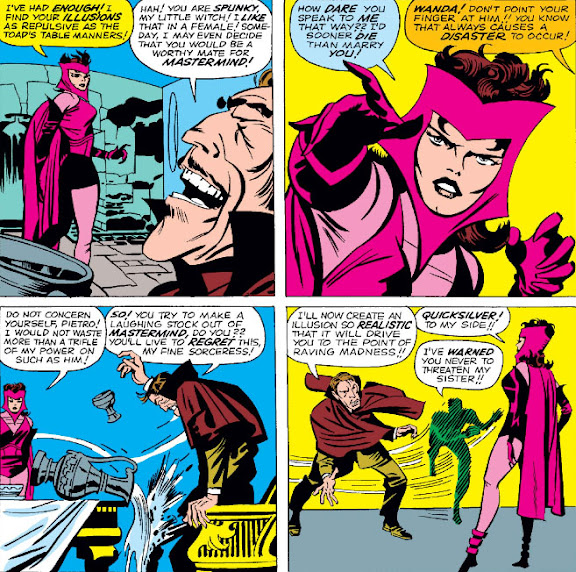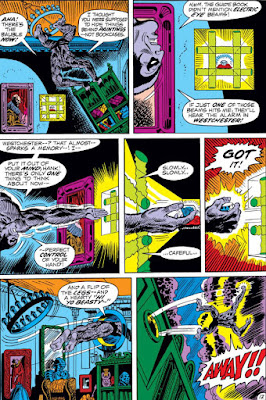Though we would come to know the suave and seductive Jason Wyngarde as the man who brought Jean Grey under his control and unknowingly unleashed Dark Phoenix as a result, it was in his identity as the malevolent villain known as Mastermind that this man began his criminal career--first as a charter member of Magneto's Brotherhood of Evil Mutants, and later striking out on his own, more or less. Mastermind has a villain name that, like his power, is somewhat deceptive, since he has no direct control of another's mind, as Mesmero and Sauron do--he merely deceives the person with illusions that he's cast. The closest he's come to mind "control" is to use a device that allows him to mesmerize his victim by casting his illusions directly into their own thoughts:
Wyngarde's appearance, as well, isn't the result of a makeover, but another illusion--a deceit he may have practiced often, since he's often had an eye for the ladies but seldom gets to first base because of his arrogance. His eye certainly fell on the Scarlet Witch often enough, during the time when she and her brother were reluctant members of Magneto's group, though it was definitely a one-sided attraction. That unfortunately didn't stop Mastermind from trying to gain her affection:
...and, not being the type to take no for an answer, trying again.
Being called "repugnant" often enough likely had Mastermind using the illusory appearance of Wyngarde (or others) as a substitute for simple courtesy and sincerity in seeking out women, if a poor one.
Mastermind would get another crack at the X-Men on his own when he later sought revenge against them for the treatment he suffered from the vengeance of Phoenix; but before we ever laid eyes on Wyngarde or even the Hellfire Club, it was Mastermind who took center stage in a 1972 story that took place while a new manifestation of the Beast was being introduced, a character who would be tailor-made for what Mastermind has in... mind.
Writer Steve Englehart and artist Tom Sutton combine their talents here to produce a Mastermind who flourishes in his wicked demeanor, dressed in his classic style of a Victorian-era caped Ulster coat which he's long preferred. Mastermind must have thought he'd gone to heaven when he became part of the Hellfire Club's inner circle, with its preoccupation with period dress--a style of wardrobe which Wyngarde had also adopted. It's in part all of those exaggerated ruffles of his outer garment which distinguish the character, as well as the thinned, disheveled hair and crazed eyes, collectively a ball that Sutton takes and runs with.
If we're to believe Englehart's interpretation of the character, Mastermind needs no technology to actually project his illusions directly into someone's mind, as it's that ability that helps enlist the Beast to his current plan. The Beast has recently battled Iron Man only to flee from the site, believing that his rage had caused him to murder the Avenger; but we now learn that it's Mastermind who's responsible for Iron Man's "death."
Mastermind thus lives up to his name; here, he does indeed control the minds of others to an extent, effectively paralyzing them (as he did Jean) while a scenario of his devising plays out in their thoughts. It's a considerable enhancement to his ability to cast illusions, and he probably has every right to brag to his two cohorts about how formidable he believes he is.
With the Beast afflicted with amnesia and not recognizing Mastermind, Unus, or the Blob, and having been on the run for a few months, he decides to grasp at the lifeline that Mastermind throws him, thanks in part to subconscious memories of his own life as a mutant, a life he spent "in hiding" as one of the X-Men.
Following the Beast's acceptance of Mastermind's offer, Englehart and Sutton add a nice touch showing Mastermind and his group hiding in plain sight as part of a traveling carnival--cover which the Blob also made use of in his early days, as well as Magneto during the time of the Brotherhood. It makes for a good change of pace for the story, while also letting Englehart deal in other ongoing subplots involving the one and only Patsy Walker, who joins her husband, Capt. Buzz Baxter, as he investigates the disappearance of Hank McCoy from his position at the Brand Corporation. There's no way Mastermind can recognize his old enemy, the X-Man called the Beast, in his present form--yet his new associate's name was enough to give him pause.
As to how the Beast figures into Mastermind's scheme, the villain has set his sights on the theft of the largest gem in the world. Fencing it will provide a great deal of cash, which will figure into a larger plan which has yet to be revealed; but it's the Beast who's the key to the success of the operation.
It's a splendid visual demonstration of the Beast's agility, as he bypasses the gem's holding place with ease--though when he returns, he has pointed questions for Mastermind as to what the man wants this gem for. Mastermind isn't feeling at all talkative on the matter, and he uses his power of illusion to compel the Beast into giving up his prize. But it's Mastermind's power against humans which is needed soon after, as a few rabble rousers are able to spot this conspicuous group of mutants appearing unexpectedly and decide to take action. It's a meeting these five men will live to regret.
Artist Frank Giacoia is finishing Sutton's pencils in this story--and while Giacoia's steady, reliable style can do no wrong, it would be interesting to see what someone like Terry Austin or Tom Palmer could do with Sutton's bold work and his one-of-a-kind depictions of the characters and scenarios he presents. (For instance, Ernie Chan's inks on Sutton's Doctor Strange work produce a final product that has to be seen to be believed.)
Returning to the carnival, Mastermind and his group make further plans, while the Beast broods about what he's done and what it is about his benefactor that keeps nagging at his mind--and before you know it, his memory returns, and all hell breaks loose as he attacks. While Mastermind bolts with the diamond, Unus and the Blob tackle the Beast--successfully at first, but eventually falling into a trap the Beast conceives to have the powers of the two work against each other in close quarters. And while Mastermind has run far from the battle, he cannot hide from the one who stalks him.
As we can see, Mastermind has once again resorted to casting illusions, which the Beast now expects and is able to circumvent. All Mastermind has to do, of course, is to again take control of the Beast's thoughts by having his illusions play out directly in his foe's mind. However, a fanged, beast-like creature charging toward him gives him no time to plan--only to fear for his life.
It's the first evidence we see of Mastermind not quite being the model of stability, either due to the threat of the Beast or a condition brought on by having his confidence in his power shattered. The Beast appears to believe the latter; and if true, it's quite a statement for a man who places such stock in his ability to manipulate others' minds and yet be such a poor custodian of his own.
 | Amazing Adventures #13 Script: Steve Englehart Pencils: Tom Sutton Inks: Frank Giacoia Letterer: John Costanza |




















1 comment:
The Beast's run in Amazing Adventures is highly underrated! Everything from the scripting to the artwork was just so on point!
Post a Comment